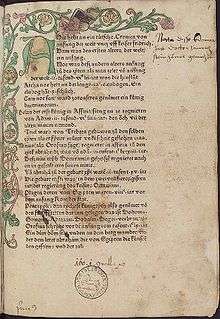Heinrich Steinhöwel
| Heinrich Steinhöwel | |
|---|---|
| Born |
1412 Weil der Stadt |
| Died |
1482 Ulm |
| Occupation | Translator |
| Nationality | German |
| Period | 15th century |

Heinrich Steinhöwel (also Steinhäuel or Steinheil; 1412 – 1482) was a Swabian author, humanist, and translator who was much inspired by the Italian Renaissance. His translations of medical treatises and fiction were an important contribution to early Renaissance Humanism in Germany.[1]
Biography
Steinhöwel studied at the University of Vienna in 1429, where he earned his Bachelor of Arts degree on July 13, 1432, and eventually his Master's Degree in 1436. He moved to Padua in 1438 and studied canon law, but later devoted himself to medicine. He graduated in 1440.[2] In 1442 he was an academic rector in Padua, and in 1444 he taught at the University of Heidelberg as rector magnificus.
In 1449 Steinhöwel was a physician in Esslingen and a year later in Ulm. Sometime after 1460 he became the personal physician of Eberhard I, Duke of Württemberg.[3]
Steinhöwel's fame comes from translating a legendary biography description of the life of Aesop and Aesop's Fables which he put into a Latin-German encyclopedic version called "Ulmer Aesop" first published in Ulm in 1476.[4] In 1477-78 he published in Augsburg from Günther Zainer a large edition of Aesop's Fables with many woodcuts.[5] In 1480 he published a German translation of Aesop's Fables based on fables of Avianus, Babrius, Romulus, and Alfred[6] which inspired other translations of later centuries in various languages worldwide.[7]
Steinhöwel also translated many works of Petrarch and Bocaccio. In 1473 he published a translated version of Bocaccio's De mulieribus claris printed by Johann Zainer in Ulm.[8] He also translated stories based on material of the works of Gian Francesco Poggio Bracciolini and Petrus Alphonsi.[6] His material was popular not only in Germany but in England, France, and the Netherlands. Steinhöwel was the center of a circle of German humanists.[9]
Footnotes
- ↑ "Renaissance - Heinrich Steinhöwel". Translate.google.com. Retrieved 2012-08-08.
- ↑ "Heinrich Steinhöwel". Translate.google.com. Retrieved 2012-08-08.
- ↑ "Bibliotheca Augustana". Translate.google.com. Retrieved 2012-08-08.
- ↑ "Aesopus; Steinhöwel, Heinrich; Brant, Sebastian". Translate.google.com. Retrieved 2012-08-08.
- ↑ Fables of Power: Aesopian Writing and Political History By Annabel M. Patterson. Books.google.com. 1991-03-26. Retrieved 2012-08-08.
- 1 2 Aesop's Fables By Aesop - Google books. Books.google.com. Retrieved 2012-08-08.
- ↑ Mastering Aesop: Medieval Education, Chaucer, and His Followers By Edward Wheatley. Books.google.com. Retrieved 2012-08-08.
- ↑ Gesamtkatalog der Wiegendrucke (Leipzig, Hiersemann, 1925), ref. GW 4486 in Armstrong paper
- ↑ McConnell, Winder (1 January 1979). "Review of Heinrich Steinhöwels "Griseldis": Studien zur Text- ünd Überlieferungsgeschichte einer frühhumanistischen Prosanovelle". Speculum. 54 (2): 384–386. doi:10.2307/2855002. JSTOR 2855002.
References
Primary sources
- Apollonius of Tire, 1471
- German Chronicle, 1473
- Mirror of human life (Rodriguez Sanchez de Arevalo), 1472
- Booklet from the pestilence, ("regimes Pestilentiae"), 1473
- Guiscardo and Sigismunda (translation of Boccaccio), 1473
- Griseldis (translation of the Latin of Boccaccio after Petrarch), 1473
- History of the cruise Gottfried Duke (translation of R. Monachus), 1461
- Of the sinnrychen erluchten Wyben (after Boccaccio's De mulieribus claris), 1473
- Esopus (fables of Aesop and Petrus Alfonsi and Gian Francesco Poggio Bracciolini), 1476–80
Further reading
 Singer, Isidore; et al., eds. (1901–1906). "Aesop's Fables among the Jews". Aesop's Fables among the Jews. Jewish Encyclopedia. New York: Funk & Wagnalls Company.
Singer, Isidore; et al., eds. (1901–1906). "Aesop's Fables among the Jews". Aesop's Fables among the Jews. Jewish Encyclopedia. New York: Funk & Wagnalls Company.- Folktales of the Jews By Dov Noy, Ellen Frankel, Dan Ben-Amos
